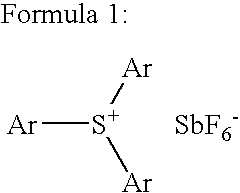Method of forming a photoresist element
a technology of resist elements and substrate films, applied in the direction of photosensitive materials, photomechanical equipment, instruments, etc., can solve the problems of coating thicknesses that are typically limited to single coating thicknesses, adhesion of coated films to substrate films, and not without problems
- Summary
- Abstract
- Description
- Claims
- Application Information
AI Technical Summary
Benefits of technology
Problems solved by technology
Method used
Image
Examples
example 1
Formulation of Dry Film Coating Composition Using Hot Melt Processing
[0069] A dry film photoresist coating composition was made by combining the components in Table 1 as shown below.
TABLE 1Formulary of the dry film photoresist coating composition of Example 1.WeightWeight %Weight %MaterialTypeSuppliergramson A + D + Fof CompSU-8 ResinResin AResolution Performance145.072.567.1ProductsNC-3000HResin ANippon Kayaku Co., Ltd.40.020.018.5ResinHeloxyReactiveResolution Performance12.06.05.6Modifier 48Monomer DProductsZ6040 SilaneAdhesionDow Corning Company3.01.51.4Promoter FCyracure 6974*PAG BDow Chemical Company16.08.07.4Total216.0100
*Cyracure 6974 contains a nominal 50.0 weight % of aryl sulphonium hexafluoroantimonate salts in propylene carbonate solvent.
[0070] A 250 ml beaker containing a magnetic stirrer and wrapped with a heating tape was placed on a magnetic stirrer hot plate. To this was added the Reactive Monomer D and the Adhesion Promoter F. This was heated to approximately 1...
examples 2-6
Dry Film Photoresist Compositions were Made by Combining the Components as Shown in Table 2
[0072]
TABLE 2Formulary of the dry film photoresist coating compositions of Examples 2-6.Example 2Example 3Example 4Example 5Example 6Weight,Weight,Weight,Weight,Weight,gmsgmsgmsgmsgms(% on(% on(% on(% on(% onMaterialTypeSupplierA + D + F)A + D + F)A + D + F)A + D + F)A + D + F)SU-8 ResinResin AResolution137.0137.0137.0137.0137.0Performance(68.5)(68.5)(68.5)(68.5)(68.5)ProductsNC-3000H ResinResin ANippon Kayaku50.0—50.050.050.0Co., Ltd.(25.0)(25.0)(25.0)(25.0)NER-7604 ResinResin ANippon Kayaku—50.0———Co., Ltd.(25.0)Heloxy Modifier 48ReactiveResolution10.010.013.013.013.0Monomer DPerformance(5.0)(5.0)(6.5)(6.5)(6.5)ProductsZ6040 SilaneAdhesionDow Corning3.03.0———Promoter FCompany(1.5)(1.5)Cyracure 6974*PAG BDow Chemical———8.0—Company(4.0)OPPIPAG BHampford8.08.08.0——Research(4.0)(4.0)(4.0)ProductsCD-1012PAG BSartomer————8.0(4.0)2-Ethoxy-8,9-Sensitizer EHampford0.120.120.12—0.12dimethoxyResearch(0...
examples 7-9
Dry film Photoresist Compositions were Made by Combining the Components as Shown in Table 3
[0074]
TABLE 3Formulary of the dry film photoresist coating compositions of Examples 7-9.Example 7Example 8Example 9Weight, gmsWeight, gmsWeight, gmsMaterialTypeSupplier(% on A + D + F)(% on A + D + F)(% on A + D + F)SU-8 ResinResin AResolution685.0685.0267.5Performance(68.5)(68.5)(53.5)ProductsNC-3000H ResinResin ANippon Kayaku250.0250.0125.0Co., Ltd.(25.0)(25.0)(25.0)NER-7604 ResinResin ANippon Kayaku——75.0Co., Ltd.(15.0)Heloxy Modifier 48ReactiveResolution65.065.032.5Monomer DPerformance(6.5)(6.5)(6.5)ProductsZ6040 SilaneAdhesionDow Corning———Promoter FCompanyCyracure 6974*PAG BDow Chemical—80.0—Company(8.0)OPPIPAG BHampford———ResearchProductsCD-1012PAG BSartomer40.0——(4.0)2-Ethoxy-8,9-Sensitizer EHampford0.60——dimethoxyResearch(0.06)anthraceneProductsTotal1040.61080.0500.0
*Cyracure 6974 contains a nominal 50.0 weight % of aryl sulphonium hexafluoroantimonate salts in propylene carbonate sol...
PUM
| Property | Measurement | Unit |
|---|---|---|
| equivalent weight | aaaaa | aaaaa |
| equivalent weight | aaaaa | aaaaa |
| particle size | aaaaa | aaaaa |
Abstract
Description
Claims
Application Information
 Login to View More
Login to View More - R&D
- Intellectual Property
- Life Sciences
- Materials
- Tech Scout
- Unparalleled Data Quality
- Higher Quality Content
- 60% Fewer Hallucinations
Browse by: Latest US Patents, China's latest patents, Technical Efficacy Thesaurus, Application Domain, Technology Topic, Popular Technical Reports.
© 2025 PatSnap. All rights reserved.Legal|Privacy policy|Modern Slavery Act Transparency Statement|Sitemap|About US| Contact US: help@patsnap.com

